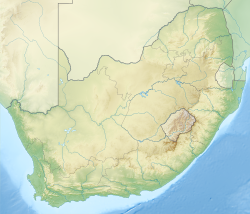
Back Mapungubwe Afrikaans مملكة مابونغوبوي Arabic Mapunqubve krallığı Azerbaijani Království Mapungubwe Czech Masarautar Mapungubwe Hausa Kerajaan Mapungubwe ID მაპუნგუბვეს სამეფო Georgian 마풍구브웨 왕국 Korean Mapungubwe Occitan Mapungubwe Shona
Kingdom of Mapungubwe Mapungubwe | |||||||||||
|---|---|---|---|---|---|---|---|---|---|---|---|
| c. 1220–c. 1300 | |||||||||||
| Status | Kingdom | ||||||||||
| Capital | Mapungubwe Hill | ||||||||||
| Government | Monarchy | ||||||||||
| History | |||||||||||
• Established | c. 1220 | ||||||||||
• Mapungubwe Hill abandoned | c. 1300 | ||||||||||
| Area | |||||||||||
• Total | 30,000 km2 (12,000 sq mi) | ||||||||||
| Currency | Possibly beads, however trade was largely conducted via barter | ||||||||||
| |||||||||||
| Today part of | South Africa, Zimbabwe | ||||||||||
| UNESCO World Heritage Site | |
|---|---|
| Location | Limpopo, South Africa |
| Criteria | Cultural: (ii), (iii), (iv), (v) |
| Reference | 1099bis |
| Inscription | 2003 (27th Session) |
| Extensions | 2014 |
| Area | 281.686602 km2 (69,606 acres) |
| Buffer zone | 1,048 km2 (259,000 acres) |
| Coordinates | 22°11′33″S 29°14′20″E / 22.19250°S 29.23889°E |
 | |
The Kingdom of Mapungubwe (pronounced /mɑːˈpuːnɡuːbweɪ/ mah-POON-goob-weh) was an ancient[a] state located at the confluence of the Shashe and Limpopo rivers in South Africa, south of Great Zimbabwe. The capital's population was 5,000 by 1250, and the state likely covered 30,000 km² (12,000 square miles).[6][1]: 50
The kingdom exhibited sacral kingship closely associated with rainmaking, and exported gold and ivory to Swahili city-states on the East African coast into the Indian Ocean trade. Although traditionally assumed to have been the first kingdom in Southern Africa, excavations in the same region at Mapela Hill show evidence for sacral kingship nearly 200 years earlier.[7] Following unknown events and shifting trade routes north around 1300, Mapungubwe's population scattered. In the present day they are often associated with the Kalanga (Shona), Tshivhula, and Venda peoples.
Despite locals having knowledge of the sacred site, Mapungubwe was popularly rediscovered on New Year's Eve 1933. The Mapungubwe Collection of artefacts found at the archaeological site is housed in the Mapungubwe Museum in Pretoria. The site is located in the Mapungubwe National Park in South Africa, on the border with Zimbabwe and Botswana.[8]
- ^ a b Cite error: The named reference
:0was invoked but never defined (see the help page). - ^ Wingfield, Chris; Giblin, John; King, Rachel, eds. (2020). The Pasts and Presence of Art in South Africa: Technologies, Ontologies and Agents. McDonald Institute for Archaeological Research. ISBN 978-1-913344-01-6.
- ^ Chirikure, Shadreck; Delius, Peter; Esterhuysen, Amanda; Hall, Simon; Lekgoathi, Sekibakiba; Maulaudzi, Maanda; Neluvhalani, Vele; Ntsoane, Otsile; Pearce, David; Sadr, Karim; Smith, Jeanette (2015). Mapungubwe Reconsidered: A Living Legacy: Exploring Beyond the Rise and Decline of the Mapungubwe State. Real African Publishers Pty. ISBN 978-1-920655-06-8.
- ^ Shabalala, Lombuso (2022). Perspective of Mapungubwe Descendants' Traditional Leaders Concerning Their Traditional Values and Cultural Heritage Preservation. Cultural Sustainable Tourism. Advances in Science, Technology & Innovation. pp. 123–134. doi:10.1007/978-3-031-07819-4_11. ISBN 978-3-031-07818-7.
- ^ Mathebula, Mantha (2017). "Some notes on the early history of the Tembe, 1280 AD-1800 AD". New Contree. 78 (78): 16. doi:10.4102/nc.v78i0.102.
- ^ Huffman, page 376
- ^ Chirikure, Shadreck; Manyanga, Munyaradzi; Pollard, A. Mark; Bandama, Foreman; Mahachi, Godfrey; Pikirayi, Innocent (31 October 2014). "Zimbabwe Culture before Mapungubwe: New Evidence from Mapela Hill, South-Western Zimbabwe". PLOS ONE. 9 (10): e111224. Bibcode:2014PLoSO...9k1224C. doi:10.1371/journal.pone.0111224. ISSN 1932-6203. PMC 4215987. PMID 25360782.
- ^ "Mapungubwe National Park - World Heritage Site in South Africa". southafrica.co.za. Retrieved 8 November 2024.
Cite error: There are <ref group=lower-alpha> tags or {{efn}} templates on this page, but the references will not show without a {{reflist|group=lower-alpha}} template or {{notelist}} template (see the help page).

